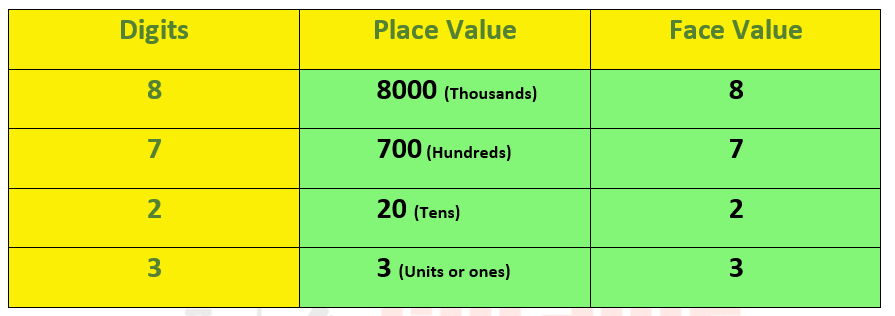NUMBER SYSTEM BRIEF
Home » NUMBER SYSTEM BRIEF

PLACE VALUE SYSTEM
INDIAN NUMERAL SYSTEM

In the number 10,23,45,678 the place values of each digit are:
· 8 – Ones
· 7 – Tens
· 6 – Hundreds
· 5 – Thousands
· 4 – Ten Thousands
· 3 – Lakhs
· 2 – Ten Lakhs
· 0 – Crores
· 1 – Ten Crores
Let us consider another number, say 225.
· The digit 2 is used twice in this number. Both of them have a different value.
· We differentiate them by stating their place value,
· The place value of the leftmost 2 is Hundreds while the one in the center is Tens.
The relationship between them is:
· 1 hundred = 10 tens
· 1 thousand = 10 hundreds = 100 tens
· 1 lakh = 100 thousands = 1000 hundreds
· 1 crore = 100 lakhs = 10,000 thousands
INTERNATIONAL NUMERAL SYSTEM

In the number 12,345,678 the place values of each digit are:
· 8 – Ones
· 7 – Tens
· 6 – Hundreds
· 5 – Thousands
· 4 – Ten Thousands
· 3 – Hundred Thousands
· 2 – Millions
· 1 – Ten Millions
The relations between them are:
· 1 hundred = 10 tens
· 1 thousand = 10 hundreds = 100 tens
· 1 million = 1000 thousands
· 1 billion = 1000 millions
COMPARISON BETWEEN INDIAN AND INTERNATIONAL NUMERAL SYSTEM

Comparing the two numeral systems we observe that:
· 100 thousands = 1 lakh
· 1 million = 10 lakhs
· 10 millions = 1 crore
· 100 millions= 10 crores
PLACEMENT OF COMMA
Commas are placed in the large numbers to help us read and write them easily. In Indian and international systems, the commas are placed at different positions.
As per Indian numeral system,
the first comma is placed after the hundreds place
after which they are placed after every two digits. E.g., 1,23,45,67,890
As per international numeral system, the first comma is placed after the hundreds place, after which they are placed after every three digits. E.g. 1,234,567,890.FACE VALUE
Face value is the value of the digit itself, in a number.
Whether the number is single-digit, double-digit, or three-digit or any number,
The face value will be the value of the digit without its placement in the face value Chart.
Let us understand with the help of examples.
Example in 89: The face value of 8 is 8 and the face value of 9 is 9.
For number 52319: The face value of 3 is 3, the face value of 5 is 5.

PLACE VALUE AND FACE VALUE
Place value of a digit = (face value of the digit) × (value of the place)
Let us take an example of a number say, 8723. Check the table below to understand the difference.

Download the PDF by clicking this link Numeral System brief



